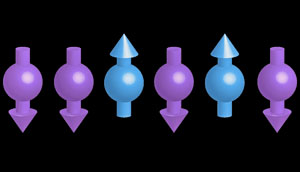Atomic-Molecular-Optical Physics

Recently, a new approach called quantum simulation has begun to be applied that is in many ways an ideal intermediate between in situ experiment and numerical simulation. In quantum simulation, we can use a well-controlled, isolated, laboratory quantum system to model the quantum many-body phenomenon of interest.
The quantum simulator utilizes the enormous, classically intractable Hilbert space we allow it to fill and, for instance, either does or does not exhibit the superconductivity we were not sure was associated with the Hamiltonian imposed on the simulator.
We are using trapped atomic ions as a platform for quantum simulations of a class of many-body quantum systems called lattice spin models. Each ion simulates the quantum-mechanical spin-1/2 degree of freedom of an electron, and by using appropriately tuned laser fields, we can cause these simulated spins to interact in a manner that is governed by the rules we impose on the system. By looking at the resulting spectra, dynamics, phase transitions, and states, we hope to learn about systems that have to this point been inaccessible to us.